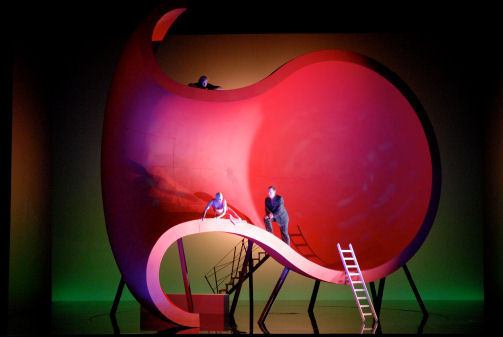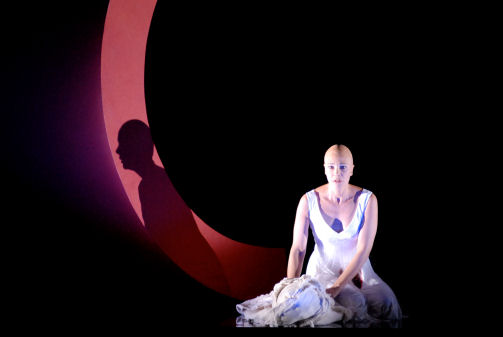Other Links
Editorial Board
- Editor - Bill Kenny
- London Editor-Melanie Eskenazi
- Founder - Len Mullenger
Google Site Search
SEEN
AND HEARD INTERNATIONAL OPERA REVIEW
Debussy, Pelléas et Mélisande:
Soloists, La Monnaie Symphony Orchestra, Conductor: Mark
Wigglesworth,
Muntschouwburg.
(La
Monnaie) Brussels 6.9.2008 (PK)
Anyone who may think Debussy's opera is about lonely, vulnerable
people, lost in life and longing for some understanding, may be
surprised by the production presented for the opening of the new
season in the Brussels Muntschouwburg. For once producer Pierre
Audi, artistic director of the Netherlands Opera where he gave birth
to a wholes series of productions characterised by utmost aesthetics
as well as human story-telling, showed a completely unexpected
approach. In Pelléas et Mélisande Audi has discovered the
dark side of humanity with Golaud as a sadomasochistic, voyeuristic
brute, sweet Mélisande as a selfish woman who constantly tries to
manipulate other people, and the old king Arkel as a dirty old man.
Only Pelléas gets a positive approach. He is longing for light and
some happiness, but unable to free himself from the people around
him: at the decisive moment he allows himself to be manipulated by
Mélisande. His death is not only the inevitable result, but Audi
gives us the impression it is also foreseen and even provoked by
Mélisande.
In general, Audi gives no answer to the
questions asked by Maurice Maeterlinck’s text. Instead he creates a
whole series of new questions that are just as unanswered. What's
more, at some moments his images come very near to kitsch, for
instance during the closing scene, when Pelléas appears
dressed in white at
the top of the set to be welcomed by the dead Mélisande who reaches
out with her arm to him.
Cast:
Stéphane Degout - Pelléas
Sandrine Piau - Mélisande
Dietrich Henschel - Golaud
Marie-Nicole Lemieux - Geneviève
Alain Vernhes - Arkel
Jean Teitgen - Un médecin
Wiard Witholt - Un berger
Valérie Gabail - Yniold
Production:
Producer:
Pierre Audi
Set: Anish Kaspoor

This unusual vision on a well known love story is situated in and
around a gigantic revolving and flaming red object by the British
artist Anish Kapoor, which dominates the performance from the first
until the last moment. Audi himself has added some other, no less
astonishing elements, for instance blood on the costume of each
character and a Mélisande who is completely bald until the last act,
when she suddenly shows a wealth of hair. (During the other acts
there is some hair too, but attached to her dresses - one for every
act.)

In the pit there was some fine orchestral playing, despite
the fact that Mark Wigglesworth had opted for a sold, 'earthy'
reading which seemed not always compatible with the ethereal
subtleties and the impressionistic character the score. The
soloists however were first rate. The music of Pelléas seems to be
written for the bright and youthful baritone of Stéphane Degout and
in Sandrine Piau he had found a warm, vocally utterly believable
Melisande. If Dietrich Henschel's Golaud was not quite on the same
level, it was only because his singing lacked some of the French
style, and certainly not because he was less convincing. An
impressive example of French singing was displayed by Alain Vernhes
as Arkel and there were also some very fine performances by Jean
Teitgen as the doctor and by Valérie Gabail as a naïve sounding (but
less naïve looking) Yniold. Moreover it must be mentioned that in
this production every word of the libretto was fully understandable
for once . In modern opera this is really exceptional!
Paul Korenhof
Pictures:
©
Maarten
Vanden Abeele
Back
to Top
Cumulative Index Page
